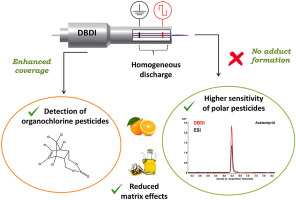当前位置:
X-MOL 学术
›
Anal. Chim. Acta
›
论文详情
Our official English website, www.x-mol.net, welcomes your
feedback! (Note: you will need to create a separate account there.)
Use of dielectric barrier discharge ionization to minimize matrix effects and expand coverage in pesticide residue analysis by liquid chromatography-mass spectrometry
Analytica Chimica Acta ( IF 5.7 ) Pub Date : 2018-08-01 , DOI: 10.1016/j.aca.2018.02.077 Felipe J. Lara-Ortega , José Robles-Molina , Sebastian Brandt , Alexander Schütz , Bienvenida Gilbert-López , Antonio Molina-Díaz , Juan F. García-Reyes , Joachim Franzke
Analytica Chimica Acta ( IF 5.7 ) Pub Date : 2018-08-01 , DOI: 10.1016/j.aca.2018.02.077 Felipe J. Lara-Ortega , José Robles-Molina , Sebastian Brandt , Alexander Schütz , Bienvenida Gilbert-López , Antonio Molina-Díaz , Juan F. García-Reyes , Joachim Franzke

|
Although electrospray ionization (ESI) remains the gold standard ionization source for LC-MS, it exhibits two main limitations: the occurrence of matrix effects and the limited ionization coverage towards nonpolar compounds. Dielectric barrier discharge ionization (DBDI) has gained attraction in recent years as a versatile ionization method in different applications and formats. Here, we report a thorough evaluation of DBDI as ionization interface for LC-MS, which reveals attractive advantages over ESI and atmospheric pressure chemical ionization (APCI) provided its singular ionization mechanism versatility. A suite of 80 pesticides across a wide range of physicochemical properties were selected and the results were compared with both ESI and APCI sources. Using a helium plasma operated in homogeneous regime with square-wave AC waveform and relatively low voltages (2.5 kV), not only DBDI was able to ionize compounds only amenable so far by GC-MS (eg. organochlorine species), but also offered a competitive performance in terms of sensitivity when contrasted with the commercial electrospray ionization source under equivalent conditions. Unlike ESI, DBDI mechanism occurs in the gas-phase, so the method is less affected by liquid-phase surface phenomena that yield ion suppression in ESI. Data collected in the positive ion mode revealed negligible matrix effect values (<10% suppression) for most of the studied compounds in different complex matrix extracts such as wastewater, orange or olive oil. This is also consistent with the absence of adduct formation whereas with ESI source, Na adduct formation is quite common with these species. In general, both sensitivity and average limits of quantitation for DBDI were similar to those obtained by ESI and better than APCI. Results showed that analyte coverage with DBDI is enhanced with respect to ESI and APCI sources being able to effectively analyze organochlorine compounds.
中文翻译:

使用介质阻挡放电电离以最大限度地减少基质效应并扩大液相色谱-质谱法农药残留分析的覆盖范围
尽管电喷雾电离 (ESI) 仍然是 LC-MS 的金标准电离源,但它具有两个主要局限性:基质效应的发生和对非极性化合物的电离覆盖范围有限。近年来,介质阻挡放电电离 (DBDI) 作为一种适用于不同应用和形式的通用电离方法而备受关注。在这里,我们报告了对 DBDI 作为 LC-MS 电离接口的全面评估,这揭示了与 ESI 和大气压化学电离 (APCI) 相比具有吸引力的优势,因为它具有单一的电离机制多功能性。选择了一系列具有广泛物理化学特性的 80 种农药,并将结果与 ESI 和 APCI 来源进行了比较。使用在具有方波 AC 波形和相对较低电压 (2.5 kV) 的均匀状态下运行的氦等离子体,DBDI 不仅能够电离目前仅适用于 GC-MS 的化合物(例如有机氯物质),而且还提供了与同等条件下的商业电喷雾电离源相比,在灵敏度方面具有竞争力的性能。与 ESI 不同,DBDI 机制发生在气相中,因此该方法受液相表面现象的影响较小,而液相表面现象会在 ESI 中产生离子抑制。在正离子模式下收集的数据显示,对于废水、橙子或橄榄油等不同复杂基质提取物中的大多数研究化合物,基质效应值可忽略不计(<10% 抑制)。这也与没有形成加合物一致,而使用 ESI 源,Na加合物的形成在这些物种中很常见。一般而言,DBDI 的灵敏度和平均定量限与 ESI 获得的相似,但优于 APCI。结果表明,对于能够有效分析有机氯化合物的 ESI 和 APCI 源,DBDI 的分析物覆盖率得到提高。
更新日期:2018-08-01
中文翻译:

使用介质阻挡放电电离以最大限度地减少基质效应并扩大液相色谱-质谱法农药残留分析的覆盖范围
尽管电喷雾电离 (ESI) 仍然是 LC-MS 的金标准电离源,但它具有两个主要局限性:基质效应的发生和对非极性化合物的电离覆盖范围有限。近年来,介质阻挡放电电离 (DBDI) 作为一种适用于不同应用和形式的通用电离方法而备受关注。在这里,我们报告了对 DBDI 作为 LC-MS 电离接口的全面评估,这揭示了与 ESI 和大气压化学电离 (APCI) 相比具有吸引力的优势,因为它具有单一的电离机制多功能性。选择了一系列具有广泛物理化学特性的 80 种农药,并将结果与 ESI 和 APCI 来源进行了比较。使用在具有方波 AC 波形和相对较低电压 (2.5 kV) 的均匀状态下运行的氦等离子体,DBDI 不仅能够电离目前仅适用于 GC-MS 的化合物(例如有机氯物质),而且还提供了与同等条件下的商业电喷雾电离源相比,在灵敏度方面具有竞争力的性能。与 ESI 不同,DBDI 机制发生在气相中,因此该方法受液相表面现象的影响较小,而液相表面现象会在 ESI 中产生离子抑制。在正离子模式下收集的数据显示,对于废水、橙子或橄榄油等不同复杂基质提取物中的大多数研究化合物,基质效应值可忽略不计(<10% 抑制)。这也与没有形成加合物一致,而使用 ESI 源,Na加合物的形成在这些物种中很常见。一般而言,DBDI 的灵敏度和平均定量限与 ESI 获得的相似,但优于 APCI。结果表明,对于能够有效分析有机氯化合物的 ESI 和 APCI 源,DBDI 的分析物覆盖率得到提高。











































 京公网安备 11010802027423号
京公网安备 11010802027423号